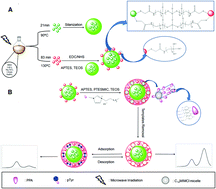Application of ratiometric fluorescence sensor-based microwave-assisted synthesized CdTe quantum dots and mesoporous structured epitope-imprinted polymers for highly efficient determination of tyrosine phosphopeptide†
Abstract
Molecularly imprinted polymer-coated quantum dots (MIP@QDs) as fluorescent sensors modified with ratiometric fluorescence techniques and mesoporous structured epitope-imprinted silica materials (QDs@SiO2@EMSiO2) were fabricated and applied for the detection of tyrosine phosphopeptide (pTyr) for the first time. The probe exhibited dual-emission peaks at 520 and 625 nm under the single excitation wavelength of 400 nm. The pTyr molecules could selectively quench the QDs, which had red emission, but the intensity of the QDs with green emission did not change; thus, it was considered as an internal reference. These phenomena caused a discernible change in the fluorescence color from orange to green under a UV lamp. In this work, phenylphosphonic acid and 1-tetradecyl-3-methylimidazolium chloride were utilized as the template molecule and template for mesoporous silica, respectively. 1-Propyltrimethoxysilane-3-methylimidazolium chloride was applied as the functional monomer and 3-aminopropyltriethoxysilane was employed as the cross-linker. Meanwhile, the conventional heating technique, namely, hydrothermal synthesis was substituted with the microwave heating method, resulting in fast, uniform and controllable nucleation and growth of the nanoparticles. The suggested epitope-imprinted polymer-coated mesoporous structured fluorescence composite compared with the non-mesoporous structured composite and single-emission MIP biosensor demonstrated excellent efficiency. Under the optimum conditions, the linear range and the detection limit obtained were 0.07–230 μM and 34 nM, respectively. Besides, the suggested nano-biosensor depicted highly reproducible results in the probing of real samples, with recoveries between 95.85% and 103.23%.



 Please wait while we load your content...
Please wait while we load your content...